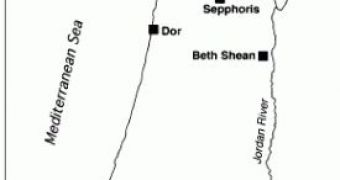High concentrations of silver were detected in samples of many different types of pottery from excavations in Jerusalem of the late Second Temple period, the first century BCE (Before the Common Era) through 70 CE (Common Era) by Frank Asaro and Robert D. Giauque of Berkeley Lab's Environmental Energy Technologies Division and David Adan-Bayewitz, Associate Professor at Bar-Ilan in Ramat-Gan, Israel.
This silver content study in archaeological ceramics is a premiere.
They made measurements on 1,200 pottery vessels from 38 sites in Roman Judea (present-day Israel).
Silver amount was measured using high-precision X-ray fluorescence (HPXRF) and a variation of instrumental neutron activation analysis (INAA) specifically designed for measuring silver amounts in archaeological samples.
"I was mistrustful of INAA measurements of abundances with a single detector and X-ray fluorescence measurements to measure silver accurately in archaeological samples," says Asaro, "so we developed a new and more reliable way of detecting silver using coincidence measurements with INAA."
Samples of pottery from Roman Judea's Jerusalem showed anomalously higher concentrations of silver compared to samples from all other non-urban sites from the same period, samples which were otherwise identical with those from Jerusalem.
But the other urban potteries also presented high silver concentrations, even if smaller than in Jerusalem.
"Because pottery samples containing higher amounts of silver were all recovered from sites in cities, and because the cities were distant from one another," says Asaro, "we concluded that the silver anomalies are associated with human activity."
Scientists think that silver was washed into the pottery through groundwater; natural causes couldn't explain this odd distribution.
"One of the most important results of our silver work is that our findings suggest that the measurement of silver in pottery may be a useful tool for evaluating archaeological remains and patterns of urban contamination in antiquity," says Adan-Bayewitz.
Jerusalem and its temple was the religious and national center of Jews throughout the Roman Empire during the Second Temple Period, leading to substantial growth and accumulation of wealth of the city's inhabitants.
The silver anomaly could be analytical evidence of the wealth of the city during this period.
The Roman scholar Pliny the Elder, who lived during this time, called Jerusalem "by far the most famous city of the East."
Josephus, the first-century Jewish historian, witnessed the siege and conquest of Jerusalem in 70 CE, and wrote "Of the vast wealth of the city, no small portion was still being discovered among the ruins. Much of this the Romans dug up, but the greater part they became possessed of through the information of the prisoners, gold and silver and other most precious articles, which the owners in view of the uncertain fortunes of war had stored underground."
INAA and HPXRF were applied by Asaro and his team for decades to study archaeological samples.
Their work was important in finding the iridium anomaly which led to a solution about the extinction of the dinosaurs through asteroid impact in 1985, and in proving that "Drake's Plate" was an archaeological fake.

 14 DAY TRIAL //
14 DAY TRIAL //